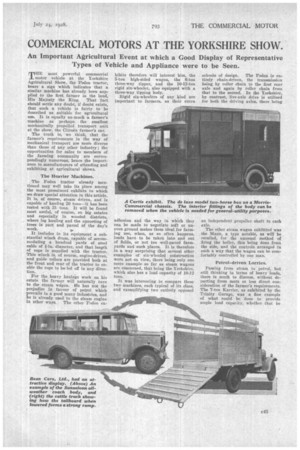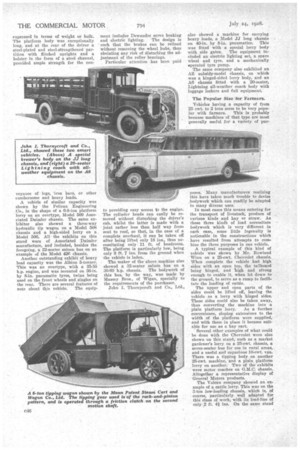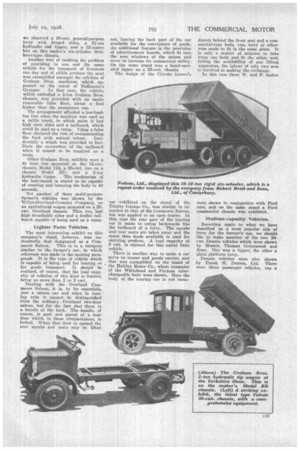COMMERCIAL MOTORS AT THE YORKSHIRE SHOW.
Page 67

Page 68

Page 69

Page 70

If you've noticed an error in this article please click here to report it so we can fix it.
An Important Agricultural Event at which a Good Display of Representative Types of Vehicle and Appliance were to be Seen.
THE most powerful commercial motor vehicle at the Yorkshire Agricultural Show, the Foden tractor, bears a sign which indicates that a similar machine has already been supplied to the first farmer in the land, His Majesty the King. That fact should settle any doubt, if doubt exists, that such a vehicle is fairly to be described as suitable for agricultural use. It is equally as-much a farmer's machine as perhaps the smallest mechanically propelled transport unit at the show, the CitroSn farmer's car.
The truth is, we think, that the farmer's requirements in the way of mechanical transport are more diverse than those of any other industry; the opportunities for sales to members of the farming community are correspondingly numerous, hence the importance to manufacturers of attending and exhibiting at agricultural shows.
The Heavier Machines.
The Foden tractor already mentioned may well take its place among the most prominent exhibits to which we draw special attention in this article. It is, of course, steam driven, and is capable of hauling 20 tons—it has been tested with 21 tons. It will be found most useful, of course, on big estates and especially in wooded districts, where log hauling and the uprooting of trees is part and parcel of the day's work.
It includes in its equipment a substantial winch drum, capable of accommodating a hundred yards ofsteel cable of kin, diameter, and that length of rope is supplied with the tractor. This winch is, of course, engine-driven, and guide rollers are provided both at the front and rear of the tractor to enable the rope to be led off in any direction.
For the heavy haulage work on his estate the farmer will naturally turn to the steam wagon. He has not the prejudice in favour of petrol which prevails in a good many industries, and he is already used to the steam engine In other ways. The other Foden ex
hibits therefore will interest him, the 5-ton high-sided wagon, the 6-ton three-way tipper, and the 10-12-ton rigid six-wheeler, also equipped with a three-way Upping body.
Rigid six-wheelers of any kind are important to farmers, as their extra adhesion and the way in which they can be made to negotiate soft or uneven ground makes them ideal for farming use, when, as so often happens, loads have to be taken into and out of fields, or not too well-paved farmyards and such places. It is therefore in a way surprising that several other examples of six-wheeled construction were not on view, there being only one more example so far as steam wagons are concerned, that being the Yorkshire, which also has a load capacity of 10-12 tons, It was interesting to compare these two machines, each typical of its class, and exemplifying two entirely opposed schools of design. The Foden is entirely chain-driven, the transmission being by roller chain to the first rear axle and again by roller chain from that to the second. ln the Yorkshire, by contrast, live-axle drive is utilized for both the driving axles, there being an independent propeller shaft to each axle.
The other steam wagon exhibited was the Mann, a type notable, as will be recalled, for the unusual method of firing the boiler, this being done front the side, and the controls arranged in such a way that the wagon can be comfortably controlled by one man.
Petrol-driven Lorries.
Passing front steam to petrol, but still thinking in terms of heavy loads, there is much to discuss, without departing from more or less direct consideration of the farmer's requirements. The 7-ton Karrier, as exhibited by the Trinity Garage, was a fine example of what could be done to provide ample load capacity, whether that be
expressed in terms of weight or bulk. The platform body was exceptionally long, and at the rear of the driver a steel-plated and steel-strengthened partition with flitched uprights and a bolster in the form of a steel channel, provided ample strength for the con veyance of logs, iron bars, or other cumbersome and heavy loads.
A vehicle of similar capacity was shown by the Pelican Engineering Co., in the shape of a 6-8-ton platform lorry on an ovcrtype, Model 509 Associated Daimler chassis. The same exhibitor also showed a three-way hydraulic tip wagon on a• Model 508 chassis and a high-sided lorry on a. Model 506. All the exhibits on this stand were of Associated Daimler manufacture, and included, besides the foregoing, a 32-seater saloon bus on an example of the Model 4241 chassis.
Another outstanding exhibit of heavy load capacity was the Albion 5-loaner. This was an overtype, with a 35-55 b.p. engine, and was mounted on 36-in. by 8-in, pneumatic tyres, twins being used on the front wheels and singles on the rear. There are several features of note about this vehicle. The equip meat includes Dewandre servo braking and electric lighting. The design is such that the brakes can be relined without removing the wheel hubs, thus obviating any risk of disturbing the adjustment of the roller bearings.
Particular attention has been paid to providing easy access to the engine. The cylinder heads can easily be removed without disturbing the driver's cab, whilst the latter is made with a joint rather less than half way from seat to roof, so that, in the case of a complete overhaul, it can be taken off after being lifted only 18 ins., thus necessitating only 11 ft. of headroom. The platform is particularly low, being only 3 ft. 7 ins, from the ground when the vehicle is laden.
The maker of the above machine also showed a 32-seater saloon bus on a 30-60 h.p. chassis. The bodywork of this bus, by the way, was made by Massey Bros., of Wigan, specially to the requirements of the purchaser.
John I. Thorn ycroft and Co., Ltd., also showed a machine for carrying heavy loads, a Model JJ long chassis on 40-in. by 8-in. pneumatics. This was fitted with a special lorry body
with side gates. The equipment included an electric lighting set, a spare wheel and tyre. and a mechanically operated tyre pump.
The same company also exhibited an AZ subsidy-model chassis, on which was a hinged-sided lorry laxly, and an A6 chassis fitted with a 20-seater, Lightning all-weather coach body with luggage lockers and full equipment.
The Popular Size for Farmers.
Vehicles having a capacity of from 25 cwt. to 2 tons seem to be very popu lar with farmers. This is probably because machines of that type are most generally useful for a variety of pur
poses. Many manufacturers realizing this have taken much trouble to devise bodywork which can readily be adapted to many diverse uses.
In most cases this means catering for the transport of livestock, produce of various kinds and hay or straw. As these three kina of load necessitate bodywork which is very different in each case, some little ingenuity is noticeable in the constructions which have resulted from attempts to combine the three purposes in one vehicle.
A typical example of this kind of vehicle was shown by Mr. Rowland Winn on a 25-cwt. Chevrolet chassis. When complete the vehicle had high sides with an open top, the tailboard being hinged, and Iiigh and strong enough to enable it, when let down to the ground, to serve as a ramp to facilitate the loading of cattle.
The upper and open parts of the sides could be lifted off, leaving the vehicle as a lorry with hinged sides. These sides could also be taken away, thus converting the machine into a plain platform lorry. As a further convenience, sloping extensions to the width of the platform were supplied, and with these in place it became suitable for use as a bay cart.
Several other examples of what could he done with the Chevrolet were also shown on this stand, such as a market gardener's lorry on a 25-cwt. chassis, a seven-seater bug for use in rural areas, and a useful and capacious 10-cwt. van. There was a tipping body on another 25-cwt. machine, and a plain platform lorry on another. Two of the exhibits were motor coaches on G.M.C. chassis. Altogether a representative display of General Motors products.
The Vulcan company showed an example of a cattle lorry. This was on the 3-ton low-loading chassis, which is, of coarse, particularly well adapted for this class of work, with its load-line of only 2 ft. 4i ins. On the same stand
we observed a 30-cwt. general-purpose lorry with hinged sides, a 21-ton hydraulic end tipper, and a 32-seater bus on this maker's six-cylinder Erisbane-type chassis.
Another way of tackling the problem of providing in one and the same vehicle for the transport of livestock one day and of edible produce the next was exemplified amongst the exhibits of Graham Bros. machines, which appeared on the stand of Hoffmann's
Garages. In that case, the vehicle, which embodied a 2-ton Graham Bros. ' chassis, was provided with an easily removable false floor, about a foot higher than the permanent one. The arrangement afforded a low-loading line when the machine was used as a cattle truck, in which guise it had high open sides and a tailboard, which could be used as a ramp. Using a false floor obviated the risk of contaminating
the food with animal refuse. Incidentally a winch was provided to facilitate the re-erection of the tailboard when it ceased to be required as a ramp.
Other Graham Bros. exhibits were a de lore van mounted on the 15-cwt. chassis, Model 124, a 25-cwt. van on a chassis Model BD. and a2-ton hydraulic tipper. The mechanism of the last-named is stated to be capable of erecting and lowering the body in 40 seconds.
Yet another of these multi-purpose farmer's vehicles was shown by the Willys-Overland-Crossley Company, on • an agricultural wagon mounted on a 25cwt. Overland chassis. This, too, had high detachable sides and a double tailboard capable of being used as a ramp.
Lighter Farm Vehicles.
The most interesting exhibit on this company's stand, however, was undoubtedly that designated as a Commerce Saloon. This is in a category similar to the farmer's car, to which reference was made in the opening paragraph. It is the type of vehicle which is capable of being used for touring or for goods transport. It should be realized, of course, that the load capacity of vehicles of this kind is limited, being no more than 2 or 3 cwt.
Dealing with the Overland Commerce Saloon, it is, in its essentials, just a saloon car and when in touring trim it cannot be distinguished from the ordinary Overland two-door saloon, but for the fact that there is a handle at the back. The handle, of course, is part and parcel of a rear door which, in these circumstances, is locked. When that door is opened the rear squabs and seats may be lifted out, leaving the back part of the car available for the conveyance of goods. An additional feature is the provision of advertisement boards, which fit into the rear windows of the saloon and serve to increase its commercial utility. On the same stand was a hand-operated tipper on a 25-cwt. chassis.
The design of the Citron farmer' car 'exhibited on the stand of the Trinity Garage Co., was similar in intention to that of the Commerce Saloon, but was applied to an open tourer. In this case the rear part of the touring car is made to swing backwards like the tailboard of a lorry. The squabs and rear seats are taken away and the space thus made available is used for carrying produce. A load capacity of 8 cwt. is claimed for this useful little vehicle.
' There is another way to make a car serve as tourer and goods carrier, and that was exemplified on the stand of the Halifax Motor Co., where examples of the Whitehead and Furness interchangeable body were shown. Here the body of the touring car is cut mime
diately behind the front seat and a commercial-type body, van, lorry or otherwise made to fit in the same place. It is only a matter of minutes to take away one body and fit the other, and, failing the availability of any lifting apparatus, the labour of only two men is involved in making the exchange.
In this case three W. and F. bodies were shown in conjunction with Ford cars, and on the same stand a Ford commercial chassis was exhibited.
Medium-capacity Vehicles.
Reverting again to what we have described as a most popular size of lorry for the farmer's use, we should like to make mention of the two 30Cwt. Dennis vehicles which were shown by Messrs. Thomas Greenwood and Sons. One was a tipper, the other a plain platform lorry.
Dennis vehicles were also shown by Frank H. Dutson, Ltd. There were three passenger vehicles, one a 20-seater bus on a Model 0 low-load-line chassis, a 32-seater "saloon bus on a•Model E machine and a 26-seater coach ou a Model F. There was also a l0cwt. Dennis on this stand, as well as a 250-300-gallon fire-engine, also on a special Model G low-load-line chassis.
The same company showed two Trojan vans, one of them ingeniously constructed to serve as a milk-roundsman's vehicle.
An interesting exhibit amongst several Austins on Mr. Greenwood's stand was a light, flat lorry on a 16 h.p.
six-cylinder chassis. The body is of special design, having a well to carry pieces of cloth, whilst the cab is luxuriously equipped to enable the owner to use the vehicle for touring purposes.
It was unfortunate that some alteration to plans, prevented Bean Cars, Ltd., from showing the new six-cylinder Sir Galahad chassis, which has we understand, undergone certain modifications in construction since the writer last saw it, notably the use of an underslung worm as a means for final drive and the arranging of the hand brake to act on a drum behind the gearbox.
The actual exhibits by this company included an 18-seater Sunshine saloon and a 20-seater saloon bhs, both on the four-cylinder chassis, and a cattle carrier mounted on a 30-cwt. chassis.
The Rigid-type Six-wheeler.
Mention has already been made in this report of the advantages of the sixwheeler as an agricultural vehicle. In this connection special interest attaches to the stand jointly run by Messrs. Eric S. Myers and C. H. Mitchell, whereon was exhibited one of the Morris 2-tonners of that particular type. Other Morris exhibits on this stand were a 30-cwt. high-sided lorry, a 1-ton van and a 1-ton lorry. There was also a Curtis de luxe two-horse box and general-utility vehicle, mounted on
Trailers.
The exhibits of trailers were few. A 5-ton hydraulic type, by the Eagle Engineering Co., Ltd., was displayed on the stand of the International Harvester Co., Ltd., hitched to an International tractor. The pump necessary to 'provide power for the type was mounted on the trailer in the place usually occupied by the belt pulley.
The Ityburn Garage and Transport Co., Ltd., showed a trailer of its own design with several features of interest, besides the fact that the construction was of steel.
The Sandon Motor and Engineering Co. showed some useful, small twowheeled trailers, designed to be towed by private cars and capable of conveying livestock, milk churns or such goods.
Motor Rollers and Mowers. Thomas Green and Son, Ltd., showed a representative series of motor-driven with cricket pitches, golf courses or sports fields generally.
A rather 'ingenious adaptation to a special purpose of Ford parts was exemplified in the B.D.V. lawn roller, made by the B.D.V. Motor Co, of Hammersmith. A Ford engine and transmission gear are bolted direct to a Ford back axle and the whole mounted on the chassis of a roller. The rear roller is driven by chain from the Ford axle shaft. Control of the transmission gear is by hand lever. This device was shown by the Halifax Motor Co.
J. H. McLaren, Ltd., showed two examples of their Diesel-type engines, one a 6Q b.h.p., four-cylindered unit and the other a six-cylindered machine. We understand that a 30 h.p. engine of this type is being assembled into a 5-ton lorry.
The Stanley Fire Engine Co. showed two examples of its products, one a Morris, the other a Ford, of the old type, We understand it was their intention to show a Model A machine, but it could not be prepared in time.
A most ingeniously designed machine of a special type was shown by R. A. Lister and Co., of Dusky. It was the well-known Auto-Truck, and is really a petrol-engined industrial trolley designed for use in factories, etc. The power unit is mounted on a single wheel in front and can turn through a large angle, thus affording unusual manceuvrability. Its load capacity is one ton, and with that weight on board it is claimed that it will climb a gradient of 1 in 14. The platform area is 6 ft. by 3 ft. 3 ins.












































































































